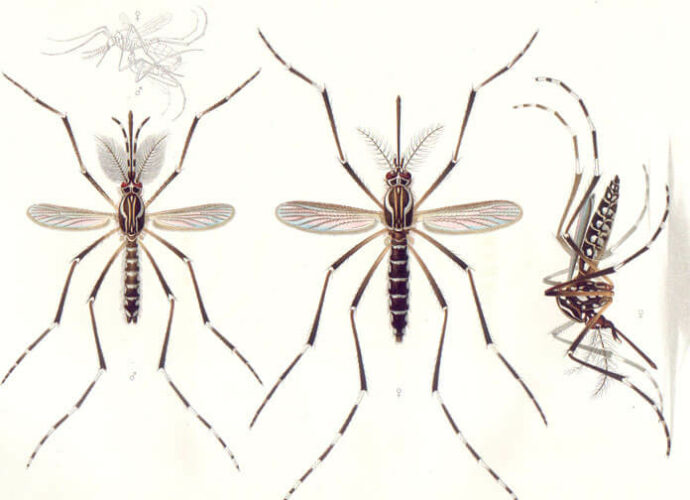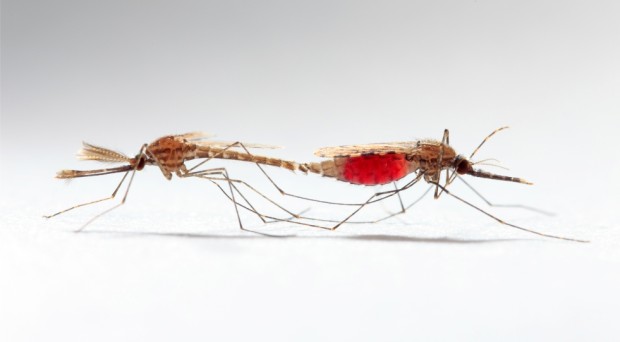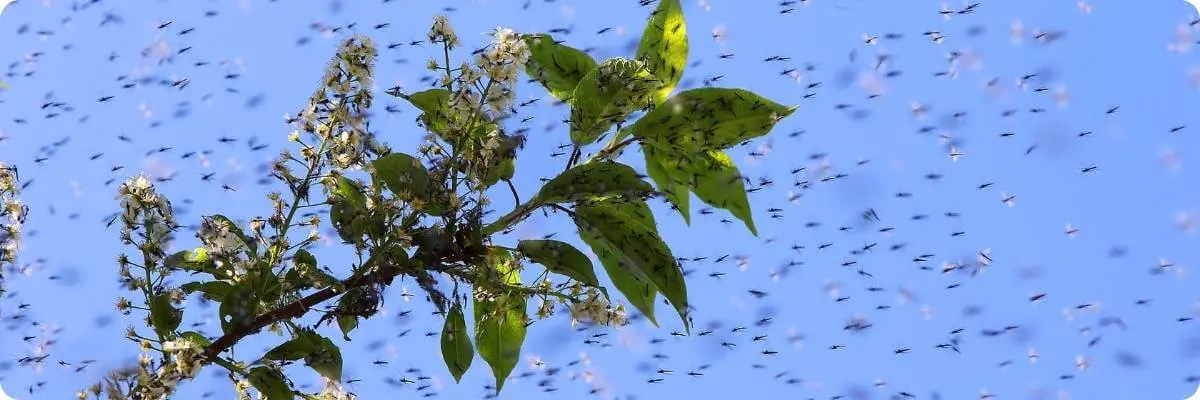Mosquitoes are certainly one of the most detested insects in the world, spreading disease and leaving itchy bites. They can ruin a summer evening barbecue in no time, and their incessant buzzing at night is exasperating.
You may know a little about the mosquito life-cycle, but have you considered how they mate? They only live for a short period, so they need to reproduce rapidly.
Much is still unknown about mosquitoes’ mating habits, but you will find some of the known facts in this article.
How Do Mosquitoes Reproduce Sexually?
Although only the female mosquitoes bite and transmit parasites or diseases, such as malaria, dengue, or yellow fever, the males play their part in increasing mosquito populations.
Mosquitoes Are Ready to Mate Rapidly
In many species, male mosquitoes are ready to mate a day or two after becoming an adult. Newly emerged male mosquitoes are unfit for coupling with a female straight away, as the external genitalia requires a morphological change. This usually takes place during the first 24 hours after emergence.
Females may be ready to mate almost immediately after they leave the pupal stage. In general, females mate before taking their first blood meal, but in some anopheles, a large proportion of virgins take a blood meal.
Mating Swarms
Many species mate in a mating swarm but there are a few exceptions.
The Opifex fuscus, or saltpool mosquito, is a mosquito found around the rocky coasts of New Zealand, has an unusual mating arrangement. The males start looking for a mate 6-24 hours after emerging. And the females’ mate at the time of emergence.
The males spend their lives on the water surface of rock pools, looking for and grabbing the trumpet or breathing tube of a female pupa close to emergence. When the female emerges, she is seized and impregnated in the first moments of her existence.
With some other species, the mating takes place near their host. The male mosquito will home in on a human or animal host, using carbon dioxide and other attractant signals. There he will wait, flying around the host, waiting for a female looking for a blood meal to approach.
Many other species use mating swarms – a cloud of hundreds of male mosquitoes at dusk or dawn. The swarms form near a landmark known as a swarm marker; it keeps the swarm in place. The marker could be a house, a chimney, a tree, or some bare earth area in a green field.
These markers have something in common, either forming a contrast on the ground or they break the regularity of the landscape.
Apparently, generation after generation of the same species swarm in the same place every year. It isn’t something hereditary, but the males born in the vicinity of the marker are drawn to it.
It is still unclear how the females locate the swarms. However, it is thought the female may use the same visual cues, the swarm markers, and olfactory cues, pheromones released by the males.
The swarms are made up almost entirely of males, with one or a few females entering at the same time. The females enter the swarm to copulate, so the males need to identify the females.
How Do the Males Find the Females?
Would you be surprised to learn that the wings play an important role in mating? Well, they do! The whining sound from the mosquitoes beating wings can attract their future partner.
Females fly into the swarm where the males detect them due to their wing beat’s specific sound frequency, which is lower than the males’ frequency.
A male will seek out the female mosquito, his wing-beat slowing. The male and female will adjust their wing beat frequency to be harmonized; this is known as harmonic convergence. This identification by wingbeat frequency is also used in non-swarming species.

Source E. A. Goeldi (1905) Os Mosquitos no Pará
Male Mosquito Antennae
The male mosquitoes hear with their antennae.
They have antennae equipped with hundreds of fine hair-like structures or flagella. These extra flagella help the males identify the females.
Incidentally, having the antennae bushier and hairier than the females is one way of differentiating between males and females.
Mosquito Sex
The act of copulation is rapid, lasting a matter of seconds, and usually takes place in the air, although it can occur on a surface. The males have a pincer-like apparatus on their abdomen, which they use to seize the female. He then inserts his aedeagus (the reproductive organ that secrets sperm) into the genital chamber.

Normally after mating, most species of female mosquitoes won’t mate again. The males can mate several times. Experts think that in many species, the female gets unknown proteins and hormones from the male seminal fluid, which means she rejects future suitors.
Fertilizing the Eggs
The proteins from the seminal fluid also induce the female to take blood meals and lay eggs. After coupling for the one and only time, the females have to store the sperm in specialized spermathecae structures.
The sperm has to be kept viable until it is needed to fertilize the eggs. During their life, the females can lay 100’s of eggs. They may take a blood meal for every batch of eggs they lay. If the temperatures are clement, this could be one batch of eggs every 7 days.
Why Understanding the Mosquitoes Mating Rituals is Important?
I hope you have found the mosquito mating routine interesting but for researchers understanding how mosquitoes mate could ultimately help them save lives.
In countries where malaria is present, deaths have been drastically reduced by the use of treated bed nets and indoor spraying. However, mosquitoes are now becoming resistant to insecticides, so other means of treatment will be needed to continue and consolidate the progress.
Previously most mosquito control strategies were based on the disease-transmitting female mosquitoes with little attention paid to the males. But the males are also responsible for the mosquito populations.
Releasing sterile or genetically modified male insects into the environment prevents the female mosquitoes from reproducing more mosquitoes that can transmit disease. Of course, this is dependent on the condition that the wild females mate with the sterile males. So, there is a need to make the sterile males more attractive than their wild male counterparts.
For example, in tests on the Aedes aegypti mosquitoes, researchers found that the size of male mosquitoes affected how the males can match the female’s sound pattern (also known as harmonic convergence).
The positive effects of convergence were most pronounced with large males and large females. For small females, size didn’t make much difference; they were interested in any male that converged.
As large females lay more eggs than small females, this could be important. If scientists release large sterile male mosquitoes that are better at attracting large females, this could boost the effectiveness of mosquito control programs, which in turn will help to prevent the transmission of disease.
Another course of action could be to target mosquito swarms to deplete mosquito populations. The swarms normally occur at about the same time and in the same locations (near the swarm markers) every day. This could make the male mosquitoes an easy target for mass killing.
A better understanding of the mosquito mating process may create new opportunities for mosquito control.

